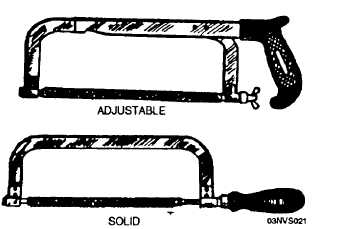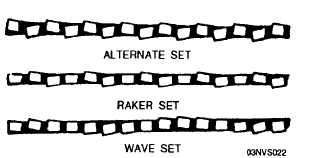work. If the blades are not at right angles to the surface
of the work, the edges of the cut will be slightly bent
and burred. The bench edge will also act as a guide
when you are cutting with the snips. The snips will
force the scrap metal down so that it does not interfere
with cutting. Any of the hand snips may be used for
straight cuts. When notches are too narrow to be cut
out with a pair of snips, make the side cuts with the
snips and cut the base of the notch with a cold chisel.
Safety and Care
Learn to use snips properly. They should always
be oiled and adjusted to permit ease of cutting and to
produce a surface that is free from burrs. If the
blades bind or if they are too far spat, the snips
should be adjusted. Remember the following safety
tips:
Never use snips as screwdrivers, hammers, or
pry bars. They break easily.
Do not attempt to cut heavier materials than
the snips are designed for. Never use tin snips to cut
hardened steel wire or other similar objects. Such use
will dent or nick the cutting edges of the blades.
Never toss snips in a toolbox where the
cutting edges can come into contact with other tools.
This dulls the cutting edges and may even break the
blades.
When snips are not in use, hang them on
hooks or lay them on an uncrowded shelf or bench.
HACKSAWS
Hacksaws are used to cut metal that is too heavy
for snips or boltcutters. Thus metal bar stock can be
cut readily with hacksaws.
There are two parts to a hacksaw: the frame and
the blade.
Common hacksaws have either an
adjustable or a solid frame (fig. 1-21).
Most
hacksaws found in the Navy are of the
adjustable-frame type. Adjustable frames can be made
to hold blades from 8 to 16 inches long, while those
with solid frames take only the length blade for which
they are made. This length is the distance between
the two pins that hold the blade in place.
Figure 1-21.-Hacksaws.
Hacksaw blades are made of high-grade tool steel,
hardened and tempered. There are two types, the
all-hard and the flexible. All-hard blades are hardened
throughout, whereas only the teeth of the flexible
blades are hardened. Hacksaw blades are about
1/2-inch wide, have from 14 to 32 teeth per inch, and
are from 8 to 16 inches long. The blades have a hole
at each end, which hooks to a pin in the frame. All
hacksaw frames, which hold the blades either parallel
or at right angles to the frame, are provided with a
wingnut or screw to permit tightening or removing the
blade.
The SET in a saw refers to how much the teeth
are pushed out in opposite directions from the sides of
the blade. The four different kinds of set are the
ALTERNATE set, DOUBLE ALTERNATE set,
RAKER set, and WAVE set. Three of these are
shown in figure 1-22.
The teeth in the alternate set are staggered, one to
the left and one to the right throughout the length of
the blade. On the double alternate set blade, two
ajoining teeth are staggered to the right, two to the
Figure 1-22.-“Set” of hacksaw-blade teeth.
1-14




